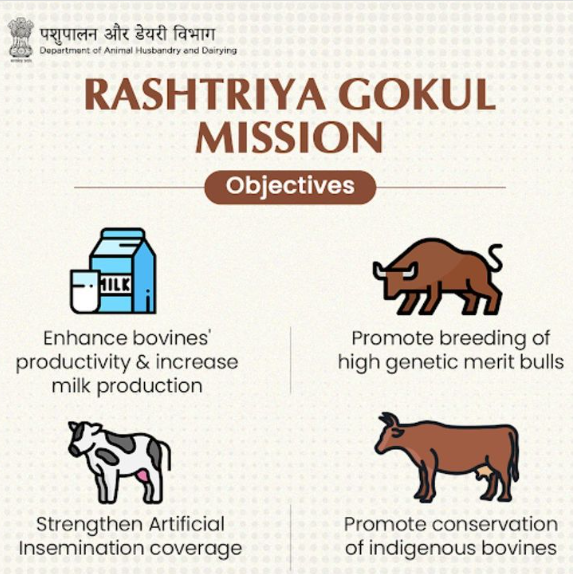5 October 2024 : Daily Current Affairs
1. Maharashtra Government Introduces Rs 50 Daily Subsidy to Preserve Indigenous Cow Breeds Amid Declining Populations
- 1. Maharashtra Government Introduces Rs 50 Daily Subsidy to Preserve Indigenous Cow Breeds Amid Declining Populations
- 2. Jaishankar will go to Pak for SCO meeting, first visit by EAM since Sushma Swaraj 9 years ago
- 3. Jaishankar meets Dissanayake, pledges India’s support for economic recovery
- 4. A tribe out of time
- 5. India’s Renewable Energy Boom: Job Creation and Sustainable Growth
- PRELIMS FACTS
- 1. Scientists Achieve First Complete Mapping of Adult Fruit Fly Brain, Paving Way for Human Brain Insights
- 2. Assam Launches Co-Districts to Decentralize Administration and Bring Governance Closer to Citizens
(Source: Indian Express; Section: Explained; Page: 19)
| Topic: GS3 – Agriculture |
| Context: |
|
Analysis of News:

Indigenous Cattle Breeds of India
- India has 50 Indigenous Bovine Breeds (37 Cattle and 13 Buffaloes).
- Milch Breeds: Specifically raised for milk production.
- Examples: Sahiwal, Gir, Red Sindhi, Tharparkar and Rathi.
- Milch and Draught Breeds: Draught cattle are employed for heavy labor purposes, aiding in agricultural activities such as plowing and transportation.
- Examples: Kankrej, Ongole, and Hariana.
- Specialty of Indian Cows:
- Hump: It is an exclusive characteristic of the Indian Desi bulls and cows and facilitates them to carry loads without effort, while the foreign breeds do not have a hump.
- Dewlap: It is a fold of loose skin hanging from the neck of an animal. The Indigenous Cattle have a high heat resistance from their extensive Dewlaps.
- Dung: The dung of Indian breeds of cows is used in agriculture, medicine, etc., whereas the dung of foreign breeds is of no use.
Proposal Details
- The subsidy will be implemented by the Goseva Ayog, with district-level scrutiny committees responsible for overseeing the process.
- Eligible gaushalas must apply online, and subsidies will be disbursed after verification.
Decline in Indigenous Cows
- Maharashtra has seen a decline in indigenous cow numbers, with the 2019 Livestock Census showing an 8.7% reduction in population compared to 2012.
- However, the official government resolution for the scheme has not clarified whether the subsidy applies to all cows or only certified indigenous breeds.
Indigenous vs Nondescript Breeds
- Indigenous cows refer to recognized breeds listed by the National Bureau of Animal Genetic Resources, while nondescript cows lack recognized breed characteristics.
- A significant proportion of Maharashtra’s cattle falls into the nondescript category, including Khillari, Deoni, Red Kandhari, and other native breeds.
Milk Production and Economic Concerns
- While indigenous cows are valued for their hardiness, their milk production is significantly lower compared to crossbred varieties, producing an average of 3.44 kg per day versus 8.55 kg for exotic breeds.
- This impacts farmers’ income, as milk yield plays a key role in their economic decisions.
The Politics of Indigenous Breeds
- The conservation of desi breeds has long been a part of the BJP’s agenda, with initiatives like the National Gokul Mission focusing on promoting indigenous cattle.
- The announcement of this subsidy comes as the state prepares for elections, reflecting a political push to appeal to rural constituencies.
Conclusion
- While the subsidy aims to preserve indigenous breeds, challenges remain regarding milk production, farmer earnings, and broader support for livestock farming.
- Most farmers are more interested in higher milk prices, which remain a crucial factor for sustaining the livestock economy.
| What is Rashtriya Gokul Mission? |
|
It is being implemented for development and conservation of indigenous bovine breeds since December 2014. The scheme is also continued under umbrella scheme Rashtriya Pashudhan Vikas Yojna from 2021 to 2026 with a budget outlay of Rs.2400 crore. Nodal Ministry: Ministry of Fisheries, Animal Husbandry and Dairying Objectives:
|
| PYQ: Livestock rearing has a big potential for providing non-farm employment and income in rural areas. Discuss suggesting suitable measures to promote this sectors in India. (200 words/12.5m) (UPSC CSE (M) GS-3 2015) |
| Practice Question: Evaluate the effectiveness of Maharashtra’s subsidy scheme for indigenous cow breeds. Discuss its potential impact on the conservation of biodiversity and the livelihoods of farmers. (150 words/10 m) |
2. Jaishankar will go to Pak for SCO meeting, first visit by EAM since Sushma Swaraj 9 years ago
(Source: Indian Express; Section: Cover Page; Page: 01)
| Topic: GS2 – International Relations |
|
Analysis of News:
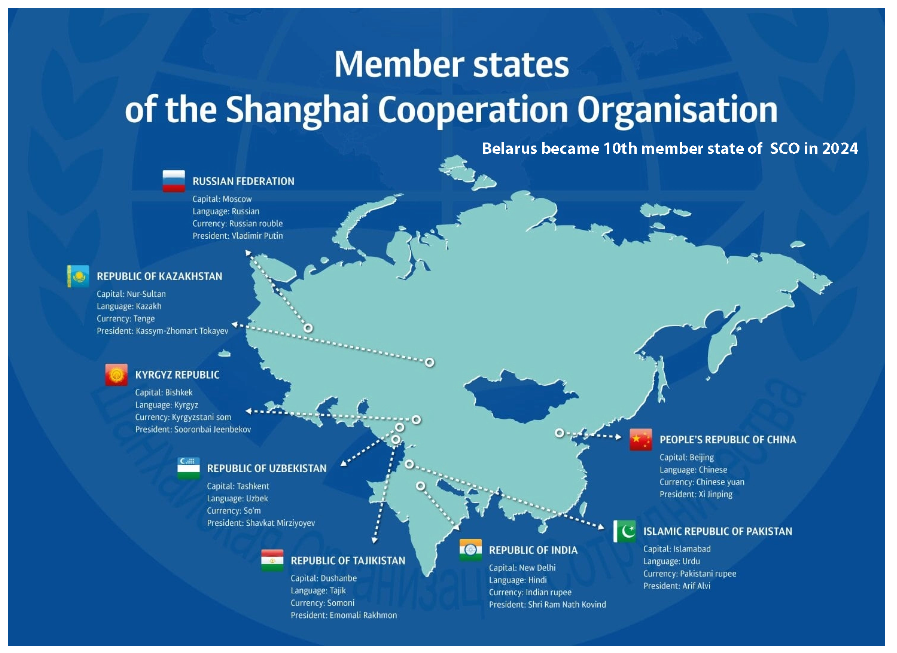
What is the Shanghai Cooperation Organisation?
Origins:
- The SCO originated from the “Shanghai Five,” formed in 1996, consisting of China, Russia, Kazakhstan, Kyrgyzstan, and Tajikistan.
- It was created to address concerns about extremist religious groups and ethnic tensions following the dissolution of the USSR in 1991.
Establishment:
- SCO was established on 15th June 2001, in Shanghai, adding Uzbekistan as a sixth member.
- Before the inclusion of Belarus, it had nine members: India, Iran, Kazakhstan, China, Kyrgyzstan, Pakistan, Russia, Tajikistan, and Uzbekistan.
- Afghanistan and Mongolia hold Observer Status.
Pakistan’s Role as Host
- Pakistan, currently holding the rotating chairmanship of the SCO CHG, extended invitations to all member states, including Indian Prime Minister Narendra Modi.
- The meeting, taking place in Islamabad, comes at a time of internal turmoil in Pakistan due to protests by supporters of former Prime Minister Imran Khan, who is jailed.
- The government has tightened security in anticipation of potential unrest during the meeting.
Past Diplomatic Engagements
- The last major diplomatic encounter between the two countries occurred in 2015 when Sushma Swaraj attended a conference in Islamabad and engaged in talks with then-Prime Minister Nawaz Sharif.
- The visit led to the announcement of a Comprehensive Bilateral Dialogue between India and Pakistan.
- Additionally, in a surprise move on December 25, 2015, Prime Minister Modi visited Lahore, meeting with Sharif, signaling a thaw in relations.
Strained Bilateral Relations
- Relations between India and Pakistan have been strained since 2019, following India’s abrogation of Article 370, which removed the special status of Jammu and Kashmir.
- Ties had already deteriorated earlier that year due to the Pulwama attack and subsequent Balakot airstrikes.
- While there was some diplomatic interaction in May 2023 when Pakistan’s then-Foreign Minister Bilawal Bhutto Zardari attended an SCO meeting in India, relations remain largely tense.
Context and Implications
- This meeting represents a rare moment of diplomatic interaction amid ongoing bilateral tensions.
- However, given the internal challenges Pakistan faces and the history of strained ties, any significant breakthrough in relations during this visit seems unlikely.
- Nevertheless, the SCO platform allows both nations to engage multilaterally, potentially easing some diplomatic hurdles.
| Relevance of SCO for India |
|
| PYQ: Critically examine the aims and objectives of SCO. What importance does it hold for India? (250 words/15m) (UPSC CSE (M) GS-2 2021) |
| Practice Question: Examine the significance of multilateral platforms like the Shanghai Cooperation Organisation (SCO) in facilitating diplomatic engagements between India and Pakistan, especially in the context of strained bilateral relations. (150 words/10 m) |
3. Jaishankar meets Dissanayake, pledges India’s support for economic recovery
(Source – The Hindu, International Edition – Page No. – 4)
| Topic: GS2 – International Relations – Bilateral Relations |
| Context |
|
Focus on Economic Support
- India highlighted its commitment to assist Sri Lanka in sectors like tourism, energy, and the dairy industry.
- The potential of leveraging India’s market for Sri Lanka’s economic recovery was stressed.
- President Dissanayake appreciated India’s $4 billion support during the financial crisis in 2022.
India-Backed Initiatives
- Ongoing India-supported projects, including those in energy, LNG supply, solar electrification, and health, were highlighted.
- These initiatives aim to enhance economic sustainability and generate new revenue streams.
- Both sides discussed the export potential of renewable energy to India.
Tourism Sector Collaboration
- Discussions included enhancing Indian tourist flows to Sri Lanka to boost the vital tourism sector.
Security and Regional Concerns
- Sri Lanka assured India of its awareness of India’s security interests.
- Support was reiterated for the aspirations of all communities in Sri Lanka, including Tamils.
Tamil Political Settlement
- The implementation of the 13th Amendment and early Provincial Council elections was emphasised.
- President Dissanayake promised a political settlement for Tamils through a new Constitution.
Fishermen Issue
- Concerns about detained Indian fishermen were raised, and their early release was requested.
- Sri Lanka recently released 50 Indian fishermen, who will be repatriated soon.
| PYQ: India is an age-old friend of Sri Lanka. Discuss India’s role in the recent crisis in Sri Lanka in light of the preceding statement. (UPSC CSE (M) GS-2 2022) |
| Practice Question: Discuss the significance of India’s economic and security cooperation with Sri Lanka in ensuring regional stability and addressing the Tamil political issue. (150 Words /10 marks) |
4. A tribe out of time
(Source – The Hindu, International Edition – Page No. – 9)
| Topic: GS1 – Indian Society |
| Context |
|
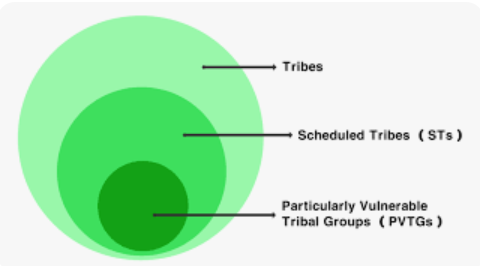
| Chenchus Tribe |
|
Problems Faced by the Chenchus Tribe
- Economic Vulnerability: Reliance on low-wage agricultural labor with insufficient income to support families.
- Loss of Employment: Discontinuation of the MGNREGS Chenchu Special Project led to reduced work opportunities and income insecurity.
- Aadhaar-Linked Challenges: Mandatory Aadhaar registration for wage payments creates barriers due to low literacy and lack of access to technology.
- Health Issues: Nutritional deficiencies, high infant and maternal mortality rates, and prevalence of genetic disorders.
- Forest Access Restrictions: Conservation laws limit their access to forest resources, impacting their traditional livelihood practices.
- Housing and Infrastructure: Deteriorating living conditions with inadequate housing, lack of electricity, and poor transportation facilities.
- Cultural Displacement: Difficulty in transitioning from a traditional hunter-gatherer lifestyle to modern agricultural practices.
| Particularly Vulnerable Tribal Group (PVTG) |
|
| Practice Question: Discuss the socio-economic challenges faced by Particularly Vulnerable Tribal Groups (PVTGs) in India, using the example of the Chenchus in Andhra Pradesh. What measures can be taken to improve their living conditions and integrate them into the mainstream economy? (150 Words /10 marks) |
5. India’s Renewable Energy Boom: Job Creation and Sustainable Growth
(Source – https://pib.gov.in/PressReleseDetail.aspx?PRID=2061902®=3&lang=1 )
| Topic: GS3 – Indian Economy – Infrastructure – Energy |
| Context |
|
Job Creation in Renewable Energy
- In 2023, India achieved a significant milestone in its renewable energy sector by reaching approximately 1.02 million jobs, as per the 2024 Annual Review by the International Renewable Energy Agency (IRENA).
- The global renewable energy workforce also saw growth, rising from 13.7 million in 2022 to 16.2 million in 2023, with India playing a crucial role in this increase.
- The report, created in collaboration with the International Labour Organization (ILO), emphasises India’s emerging leadership in clean energy and its commitment to generating green jobs that stimulate economic growth.
Economic and Employment Impacts
- The growth of renewable energy in India is pivotal not only for economic advancement but also for creating sustainable livelihoods for millions of citizens.
- The sector contributes significantly to shaping a greener future, supporting India’s journey toward energy independence and environmental sustainability, while simultaneously providing new employment opportunities across the nation.
Key Findings from the 2024 Report
- India had 1.02 million renewable energy jobs in 2023.
- Hydropower emerged as the largest employer, contributing around 453,000 jobs, representing 20% of the global total, second only to China.
- The solar PV sector employed approximately 318,600 people in on-grid and off-grid systems, with India ranking fifth globally for new installations in 2023.
- India’s operational module manufacturing capacity was 46 GW in 2023, expected to increase to 58 GW in 2024.

Annual Electricity Generation from Renewable Sources
- India’s commitment to renewable energy is reflected in annual electricity generation trends, showing a steady increase in the percentage share of renewable energy in total generation over recent years.
Major Government Initiatives
- India’s transition to sustainable energy is bolstered by key initiatives such as the National Green Hydrogen Mission, PM-KUSUM, PM Surya Ghar, and the PLI scheme for solar PV modules.
- These programs not only drive renewable energy adoption but also generate substantial job opportunities.
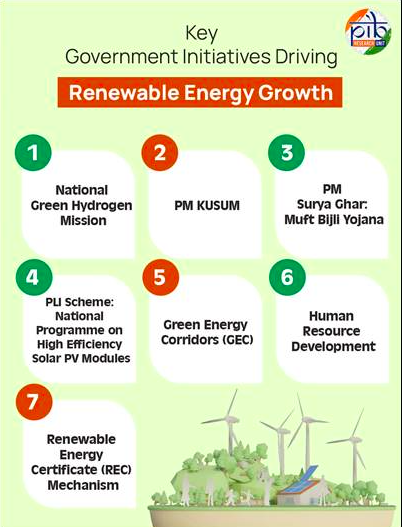
National Green Hydrogen Mission
- Launched in January 2023, this mission aims to establish India as a global hub for green hydrogen production, usage, and export, with a financial backing of ₹19,744 crore.
PM-KUSUM Scheme
- Launched in March 2019, this initiative focuses on providing energy and water security to farmers, while also generating employment opportunities estimated at 7.55 lakh job-years.
PM Surya Ghar: Muft Bijli Yojana
- This scheme, initiated in February 2024, offers free electricity through subsidised solar panel installations and is expected to create around 17 lakh direct jobs.
PLI Scheme for Solar PV Modules
- Aimed at achieving Giga Watt-scale manufacturing, this initiative focuses on promoting high-efficiency solar PV module manufacturing in India.
| PYQ: Do you think India will meet 50 percent of its energy needs from renewable energy by 2030 ? Justify your answer. How will the shift of subsidies from fossil fuels to renewables help achieve the above objective? Explain. (UPSC CSE (M) GS-3 2022) |
| Practice Question: Discuss the significance of the renewable energy sector in India’s economic growth and job creation, citing recent data and government initiatives. What challenges does India face in achieving its renewable energy targets, and how can they be addressed? (250 Words /15 marks) |
PRELIMS FACTS
1. Scientists Achieve First Complete Mapping of Adult Fruit Fly Brain, Paving Way for Human Brain Insights
(Source: Indian Express; Section: Explained; Page: 19)
| Context: |
|
Analysis of News:
Methodology: Mapping the Brain
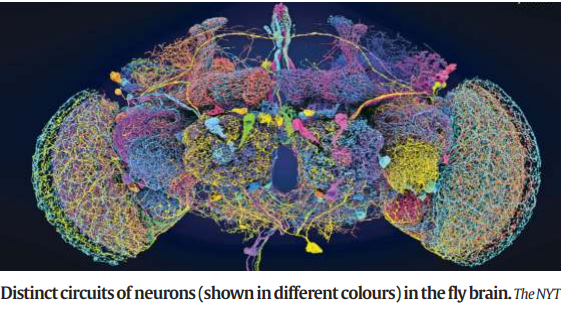
- The brain-mapping process began in 2013, starting with a chemical treatment to harden the fruit fly’s brain into a solid block.
- Researchers then shaved ultra-thin layers from the brain and captured microscopic images. A total of 7,050 sections were photographed, resulting in over 21 million images.
- After more than a decade, this work produced the first high-resolution map of the fruit fly’s brain.
Significance of the Findings
- The map revealed more than 50 million neural connections between over 139,000 neurons.
- Additionally, researchers classified 8,453 distinct cell types, making it the most extensive brain cell catalog to date.
- These findings provided insights into how different types of cells function, how the fruit fly processes visual information, and the discovery of “hub neurons” that may facilitate faster information flow in the brain.
Implications for Broader Research
- While the human brain is vastly more complex than that of a fruit fly, the fundamental principles, or “source code,” behind neuron communication and interaction are similar across species.
- This research could lead to better understanding of other animals’ brains and, eventually, the human brain, offering new avenues for treating neurological disorders.
2. Assam Launches Co-Districts to Decentralize Administration and Bring Governance Closer to Citizens
(Source: Indian Express; Section: Decision 2024; Page: 06)
| Context: |
|
Analysis of News:
Structure and Purpose of Co-Districts
- The co-districts are smaller administrative units within Assam’s districts and will be led by an officer of the rank of Assistant District Commissioner.
- These offices will handle key responsibilities, including land revenue, development, welfare, excise, and disaster management.
- Additionally, they hold magisterial powers, enabling them to issue permissions for events, ration cards, caste certificates, and land sale permits.
Phased Rollout and Scope
- The first phase of the rollout started on Friday with 21 co-districts inaugurated, and it will continue until Saturday when 39 co-districts in total will be established.
- Sarma’s government plans to expand the initiative across all 126 assembly constituencies of the state, significantly increasing administrative outreach.
Aims of the Initiative
- The primary goal of this initiative is to bring governance closer to citizens’ homes, streamlining processes and improving accessibility to essential services.
- Sarma described it as a unique move toward “minimum government, maximum governance,” making Assam the first state in India to adopt such a decentralized district administration model.

